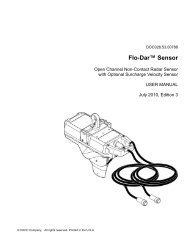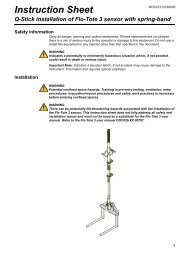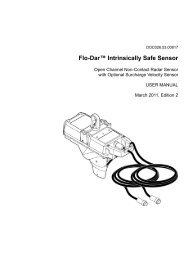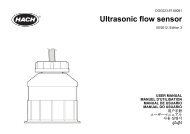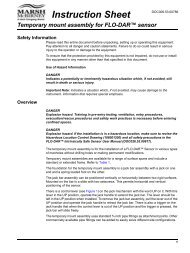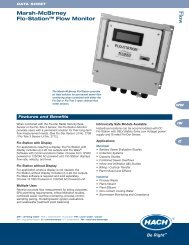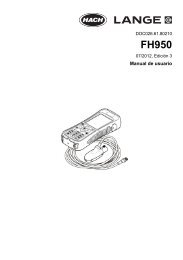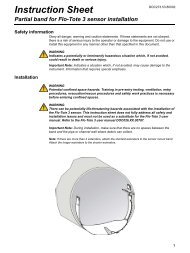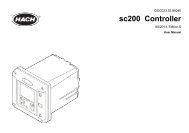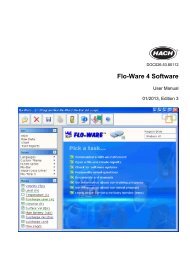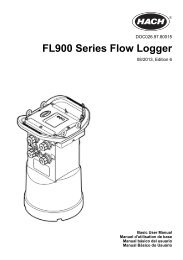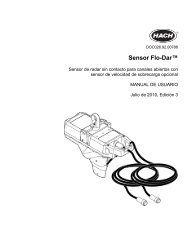FH950 User Manual English - Hachflow
FH950 User Manual English - Hachflow
FH950 User Manual English - Hachflow
Create successful ePaper yourself
Turn your PDF publications into a flip-book with our unique Google optimized e-Paper software.
Operation<br />
Stream profiles<br />
Stations and station spacing<br />
For a well-chosen cross-section, division into 25 to 30 partial sections is typically sufficient. If the<br />
cross-section is very smooth and the velocity distribution very consistent, it is possible to decrease<br />
the number of stations.<br />
Make the distance between the partial stations so that no individual station contains more than 10%<br />
of the discharge. The ideal measurement is one in which each partial station contains 5% or less (≤<br />
5%) of the total discharge, but this is rarely possible when 25 stations are used. Partial stations<br />
should not have equal widths across the entire cross-section unless the discharge is well-distributed.<br />
Distances between stations are generally smaller where water depth and flow velocities change<br />
significantly. Places where depth and velocities frequently change significantly include bank areas,<br />
vertical or steep slopes, ledges in divided cross-sections and transitions from the main stream bed to<br />
the foreland. Stations should also be located at points of significant changes in the stream bed<br />
profile.<br />
The measurement cross-section must be set at right angles to the direction of flow. Cross-sections<br />
must not contain still areas, counter currents or eddies. Do not put the sensor in deep pools, below<br />
large inflows, or near ship moorings, ferries or sluices.<br />
Use Table 3 as a guide for the number of stations necessary for an acceptable measurement. The<br />
information is based on EN - ISO 748 standards.<br />
Table 3 Number of stations in relation to the waterway width<br />
Feet Meters Number of stations<br />
< 1.6 < 0.5 5 to 6<br />
> 1.6 and < 3.3 > 0.5 and < 1 6 to 7<br />
> 3.3 and < 9.8 > 1 and < 3 7 to 12<br />
> 9.8 and < 16.4 > 3 and < 5 13 to 16<br />
> 16.4 ≥ 5 ≥ 22<br />
Measure velocity<br />
Measurement quality is dependent on the correct selection of a measurement cross-section. Select a<br />
section of stream with the following characteristics:<br />
• The flow directions at each measurement point across the stream are parallel to the bank and<br />
perpendicular to the cross-section.<br />
• The streambed is stable and free of large rocks, weeds and protruding obstructions such as piers<br />
that cause turbulence.<br />
It is often not possible to completely satisfy all of these conditions. Use the criteria to select the best<br />
possible section and then select a cross-section.<br />
The general procedure to take velocity measurements in river and stream profiles is described below.<br />
Make the first measurement in a stream profile at the top. Make each subsequent measurement<br />
below the last one.<br />
• In fixed mode, divide the channel into stations of equal width.<br />
• Conduct a velocity measurement at each station. The portable meter shows and stores the depth<br />
and measured velocity information.<br />
• When the stream profile is completed, the meter automatically calculates the total flow.<br />
For accurate measurement results, stand to the side of the instrument. Refer to Figure 9.<br />
18 <strong>English</strong>



